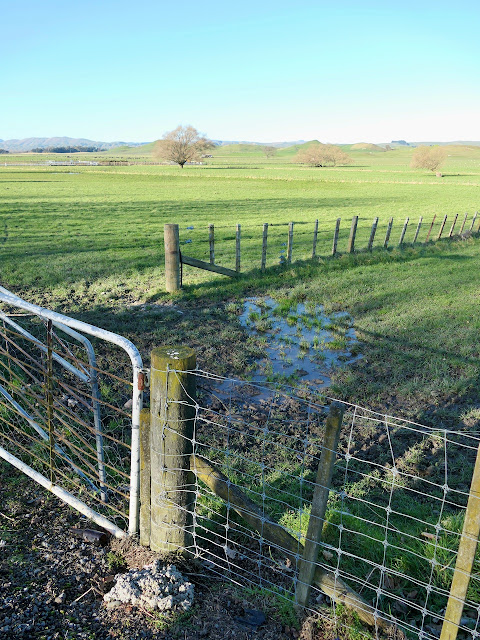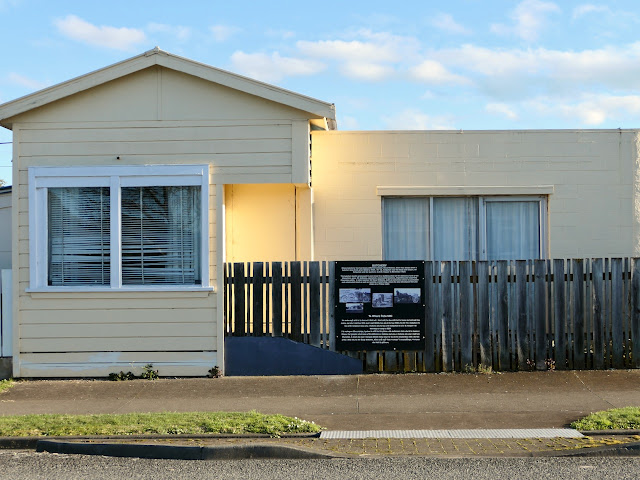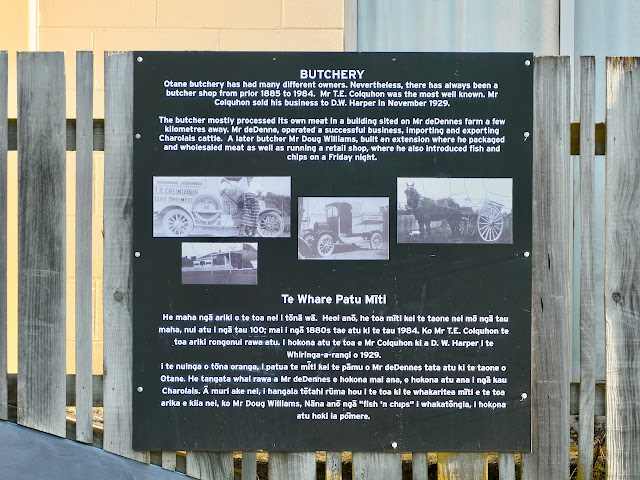So often, life unfolds in ways we least expect- like when Hawke's Bay was overwhelmed by cyclone Gabrielle and the subsequent massive flooding back in February. So many lost their homes, animals, crops and livelihoods, and some even their lives. It's been almost six months and much progress has been made and...it hasn't. Many parts of our province are still hurting and reeling. It's been a wet winter- we're all sodden and there's lichen and mould growing on fences, rooves and letter boxes all over the place. What we didn't expect was to pay an unexpected price of our own: that of severe sleep loss and disruption due to KiwiRail moving their Port operations to Hastings after the rail line was broken in the flood. The decision is understandable, but the consequences thoughtlessly brutalistic. A giant hoist used for unloading containers, three shunting locomotives and the 24 hour operation of three or more industrial forklifts, often working simultaneously, has been intense in our neighbourhood and highly invasive. It took quite some detective work to sort out what had even happened and why I was hearing beeping every night. Some nights it was so intense I didn't sleep at all and my nervous system began to break down- so scary! After some fudging and denial the truth emerged that between KiwiRail and Toll we had an unfettered industrial overwhelm going on, masked by the closer operations of Watties and the canning place Jamestrong. All in the centre of the city and encircled by urban housing- many of these homes were built a century ago. It's disempowering, isolating and lonely suffering industrial abuse. It turns out that they're never going to turn those backing beepers off come hell or high water. And of course forklifts mainly work in reverse. A modern conundrum of their own bureaucratic making.
Where do you go when you cannot sleep in your own home?
It did help to learn that when the rail link is repaired (hopefully by the 18th September) all the extra activity will retire back to the Port again- where it jolly well belongs.
So, I have made myself some rhodiola tincture, and found my milky oat tincture- nervines to support my nervous system.
We've been walking lots and also planned some small overnight stays in quiet places.
On Monday (31st July) we headed down to Otane- a wee village only 20 minutes from home.
We stopped in at The Paper Mulberry cafe for scones & coffee and spotted some delightful knitting on offer.
Such cute little woollen socks!
Sensible place to hang the cafe washing.
"
This beautiful historic building has been around pre Napier’s earthquake in 1931 making it 110 years old. October 1999, the weekend before labour weekend was the opening debut of the cafe! Dave and Lyn Robinson, along with Geoff and Jan Speeden, worked as a team to bring this Café to life" 
Jan and Geoff still live just nearby on their wonderful property known as
Millstream Gardens.
They have created a unique, sustainable and richly wonderful life for themselves:
"We run a small cottage industry here at Millstream Gardens, interweaving making ointments and oils, packing orders, and tending to our ramshackle herb and vegetable gardens. “Small is Beautiful” is our motto, and we have resisted the pressure to expand a number of times, as we don’t want to compromise the way we grow our herbs and make our natural remedies. Growing and harvesting with intent and mindfulness is an integral part of our business and we feel it would be hard to retain this core value if we had to outsource or grow on a larger scale."So, of course we called in for a wee visit and look who we found at the door.
Jan in the shop packing up an order.
Just the most resourceful and knowledgeable couple.
I love the quirky bits and pieces all around the shop.
And the innovative stuff too like these gorgeous labels that were created by the local artist Sophie Blokker, especially for Millstream Gardens shop.
It's a special piece of land alright.
Lucky there's lots of space for everything- including unusual trees and plants and caravans and buses!
It was suggested that when we left we might like to take a right in to the loop of College road, as it re-emerges at Otane.
What beautiful pastoral land.
This little brook was so pristine and delightful!
A bubbling brook!
Wondering what the crop was in the paddock across the road I discovered plantain and speedwell.
Sounds like a regenerative sowing to me.
And just like that we arrived at Otane and the old pottery run by Bob Huck back in the day called The Phoenix. Of course it's now been converted in to accommodation.
Goodness there's quite a story that goes with The Phoenix pottery- pretty important in Hawke's Bay in it's time although Bob started out in Havelock North before moving to Otane. Before all the imports, Bob made all the pots for local gardeners.
.jpeg)
The Phoenix is a nice airy space now.
But my word those cobblestones were absolutely freezing in the middle of winter!
I found Bob's story fascinating. If you're interested you can catch up with it here at the Knowledge Bank.So lovely to be able to see the Linden avenue through the arched window.
We visited the trees back in December when they were in full fragrant bloom.
It's interesting the evolution of small town New Zealand. Back in it's Hay Day Otane's population swelled to 22,000. I'm not at all sure where everyone actually lived. In these days it's a tiny town with a teeny playground.
A silt dump of their own.
A railway track running through it.
And here is so random information about the Otane train station that was once sited here:
"The railway line was opened in September 1876. Prior to this it was a four day journey by bullock
wagon to reach Napier. The original Railway Station buildings also housed the Post and Telegraph
office. These were destroyed by fire on 1st February 1894. A new one was built.
The original train signals were manned and each train was given a tablet. The sidings were plentiful,
with its Stockyards, Goods Shed and Loading Bank. New Zealand Rail purchased land on the
northern side of the line to plant Oak trees- Oak was the best fuel to fire steam trains at the time.
Just before planting commenced. coal became the fuel of choice.
A large water tank was constructed beside the station for the use by steam trains.
In the early 1960's the Station was dismantled and a concrete and brick Station building was erected
in its place.
Otane was the last Station to have semaphore signalling, that is a Wooden Arm On a high pole.
From 2nd December 1986 Otane became a table ‘switch out/switch in‘ station and distant
signals were removed to be replaced by coloured lights
In 1980's the Station was closed, including the Goods Shed and Siding".
Otane seems to have fared pretty well after the cyclone of 2023, but everywhere we look the land was still sodden with all the rainfall we've had this winter.
It's such a shame to see the vitaily fade out of a rural township. This old library building was restored and became a jolly good little cafe for a few years but it appears to have closed again.
There's been a splendid effort made by the present community to record history all around the little town, but there's a sadness within the quiet- a certain draining of purpose and vitality.
The Soap Factory sounds a bit scary!
.jpeg)
I love these old railway houses. Such a distinctive design.
Now that is grand creativity.
I find rural neglect challenging. Once a significant property on the outskirts of the village..
More mud!
And new lambs.
.jpeg)
Poor little darlings being born in to the freezing cold.
And up comes the first of the August blue moons.
Oh and it turns out that Otane was at first known as Kaikora. And this was the school that opened in 1886. Thank goodness that when tenders were called for the buildings demolition in 1986 a group of residents came riding in to save the day.
There are more Lindens planted at the back of the old school.

And now also a Pataka Pa- where the community can share extra food and produce.
.jpeg)
Goodness it really was quite another place back in 1865!
Nice to see some maintenance being done on the old post office building.
A macrocarpa lost to the cyclone- that'll keep them in firewood a good long while.
As I understand things the railway wasn't set up in Otane (Kaikora at the time) until 1867, yet there was a bakery on the go in 1850 (& before) even though a trip to Napier by bullock cart was expected to take up to four days!! And even if there were flour mills at Ongaonga and Pukehou (which in itself is astonishing as we don't grow a great deal of grain in Hawke's Bay these days), then the process of baking bread for the community was quite a feat, especially as the wood used to fire the ovens was coming out of the then surrounding native bush.
Then there was a butcher...
There's an informative pdf The Historic Pavement Walk that you can find just
here, if that's of interest to you.
Mentioned is A section of a letter written by Mary Tod to her uncle in England in May 1891 "Everyone rides here and you seldom meet anyone on foot along the roads. Children ride from school, old ladies and young ladies, workman, trades people and everyone. Maori women ride with their children attached to their backs."
It was also noted that "In days gone by Otane residents had one or two cows each to supply their needs for milk, butter and cheese.At the time, one cow per rate-paying resident was permitted to graze upon the road-side without fear of being impounded."
And evidently some nicely crafted houses were also made using the wood from the surrounding forests.
Fragrant sweet violets along the footpath.
.jpeg)
Chawton was one of the earlier homes built in in Otane, yet it was twelve years after the land was purchased before the house was built. It's interesting how these early immigrants brought with them all their hopes & dreams & plans- no matter how unrealistic the outworking of these plans they had a good go anyway. Chawton was named after a small village in Hampshire, England where the renowned author Jane Austen lived. Mrs Sharples carefully laid out the gardens to replicate the original plans & plantings of Jane Austen's house. It's interesting how the telling of stories evolve, however, as it mentions on the Jane Austen website these few notes concerning the garden:
"In Jane Austen’s time the garden was bigger than it is today. It boasted lawns, flower beds, an orchard, a shrubbery walk and also a large vegetable patch which Jane’s mother tended.Although no record of its layout exists, it is probable that this garden was of simple country cottage style with little formal design."
You have to wonder just how much actual gardening Mrs Sharples had done herself before arriving in Kaikora. You can find a few photos of Jane Austen's garden just
here.
And then there was the Station Master's house.
Life was tough in those days and death is often untimely and inconvenient. In the year of the town's inception there was a burial and then more to come, but as the memorial crosses were fashioned from local Totara they were rendered vulnerable when a spark from a passing steam train ignited the grass and the crosses burnt.
Here's the modern day solution- a low care, timeless memorial space.
On our journey home the following day we took College road in reverse ...
Looks like an old dairy (a real one not a corner shop) perhaps.
It was so wonderful to see Totara and Titoki trees in the hills- stands of native trees we never knew existed. We're pretty barren here in Hawke's Bay which is troubling.
..but then we veered off in the middle of the journey and found ourselves at Argyll school. We stopped just here to absorb what we were learning and a local came to our rescue imagining we were lost. She advised us to keep going straight ahead and then take Te Onepu road.
So close to home, yet completely unfamiliar landscape to us.
Finding the road lined with healthy walnut trees all of a sudden was so exciting. So many of them.
And then the decent- winding our way down again
through these fresh landscapes
to find ourselves abruptly delivered out to the main road.

.jpeg)
.jpeg)

.jpeg)

.jpeg)

.jpeg)
.jpeg)








.jpeg)


.jpeg)
.jpeg)
.jpeg)
.jpeg)
.jpeg)
.jpeg)

.jpeg)
.jpeg)
.jpeg)

.jpeg)
.jpeg)
.jpeg)


.jpeg)
.jpeg)
.jpeg)


.jpeg)
.jpeg)
.jpeg)
.jpeg)
.jpeg)
.jpeg)



.jpeg)


.jpeg)




.jpeg)













.jpg)
.jpeg)



.jpeg)
No comments:
Post a Comment